
The Prattville Dragoons were a company of men from the city of Prattville, and Autauga County, Alabama, organized for Confederate service during the American Civil War of 1861-1865.

The Prattville Dragoons were a company of men from the city of Prattville, and Autauga County, Alabama, organized for Confederate service during the American Civil War of 1861-1865.

The Prattville Dragoons were the first Company of men from the city of Prattville, and Autauga County, Alabama, to form for service in the impending American Civil War of 1861-1865. The idea for forming a Company was originally suggested by Samuel D. Oliver, from nearby Robinson Springs, Alabama. The Company organized on December 8, 1860 in the west front parlor of the home of George L. Smith (now the Prattaugan Museum.), [1] The Company was formed as a part of the "Alabama Volunteer Corps" and in her book Hon. Daniel Pratt, Mrs. S.F.H. Tarrant states that "... Mr. Pratt presented to every member of this cavalry company a uniform, made of black broadcloth, trimmed with gold braid. No other company in the State had a uniform so handsome."
In his book War History of the Prattville Dragoons Captain W.F. Mims (the last Commander of Co. H, 3rd Ala. Cav., CSA) spoke fondly of Pratt's generosity, stating, "Many not being able to furnish their mounts were greatly discouraged. That great and good man, Daniel Pratt, so well known for deeds of charity and generosity, supplied the defeiciency at a cost of many hundred dollars." (Quoting Historian Tommy Brown of the Continental / Eagle Manufacturing Company - still producing cotton gins in Daniel Pratt's buildings - "Daniel Pratt was Alabama's first millionaire.") The rank of "Captain" was voted by the members of the Unit, and the first Captain of the Prattville Dragoons was Jesse Cox "of Steamboat notoriety" from Mobile, Alabama. In total, there was originally "18 commissioned and non-commissioned officers and 82 privates, total 100, with two faithful colored cooks." The soldiers formed for their send-off at the school yard of the Prattville Academy and was presented a beautiful silk flag that was sewn by hand by the young ladies of Prattville. On Confederate Memorial Day in 1916, a large boulder with a bronze plaque was placed on that site to honor the Dragoons by the United Daughters of the Confederacy.


The Prattville Dragoons rode first to the Fair Grounds in Montgomery, Alabama, and then partially by train, and partially by horseback to Pensacola, Florida, to the Camp of Instruction there being led by General Braxton Bragg. The majority of the Prattville Dragoons brought their personal civilian and hunting firearms with them, but those lacking arms were issued Colt 1851 Navy Revolvers and sabers. While in Pensacola, the Prattville Dragoons were first assigned as the "mounted" Company "I" of the 7th Alabama Infantry. They left Pensacola in February 1862 traveling light and suffered through snow, sleet and rain in Chattanooga, Tennessee, that March. They marched further and participated in the Battle of Shiloh in April 1862. When their initial term of enlistment expired, the Unit en masse reenlisted and was accepted as Company "H" of the 3rd Alabama Cavalry in Tupelo, Mississippi, in June 1862. Captain Cox returned to the steamboat business, and Wilbur Fisk Mims was voted into the Captain position. As a Company of the Third Alabama Cavalry, the Prattville Dragoons accompanied the Confederate Army of Tennessee into Kentucky and were engaged in daily conflicts with the enemy, particularly at Bramlet's Station and the Battle of Perryville. It fell back with the army, and was on constant and arduous duty during the remainder of the war, protecting its communications, guarding its rear and flanks, and often raiding upon the enemy's trains and outposts. The whole regiment was a part of the brigade composed of the First, Third, Fourth, Ninth, Twelfth, and Fifty-First Alabama Cavalry, commanded first by Gen. Allen of Montgomery, then subsequently by Gen. Hagan of Mobile.

The Third Alabama cavalry was engaged at Stones River; Shelbyville; Chickamauga; Kingston; Knoxville; Mossy Creek; Strawberry Plains; ... losing continuously in casualties, and suffering severely during General James Longstreet's winter campaign. As the 3rd and her Company's fought in Dalton and Atlanta it performed arduous service, fighting with severe loss at Decatur, and helping to capture General Stoneman's column. In front of General William T. Sherman, the regiment shrouded General Hood's movements, then harassed the former on his march, participating in the fights near Macon; at Winchester; Aiken; Fayetteville, Monroe's Crossroads (where Confederate and Union troops engaged in the last cavalry battle of the Civil War); the Bentonville; Raleigh and Chapel Hill. Reduced by its losses to a skeleton, the regiment was surrendered in North Carolina as a part of General Joseph E. Johnston's surrender on April 26, 1865. The Prattville Dragoons encamped to await Union parole, but after remaining dormant for several days without any sign of Union Officers to officially parole them, the Unit disbanded and returned to their homes.

Autauga County is a county located in the central portion of the U.S. state of Alabama. As of the 2020 census the population was 58,805. Its county seat is Prattville.

Daniel Pratt was an American industrialist who pioneered ventures that opened the door for industry in Alabama. Prattville in Autauga County, Alabama, and Birmingham's Pratt City in Jefferson County, Alabama on the Pratt coal seam are both named for him. He is buried in Daniel Pratt Cemetery, located on top of Ginshop Hill near downtown Prattville, Alabama.

The 15th Pennsylvania Cavalry Regiment, known as the Anderson Cavalry and the 160th Volunteers, was a three-year cavalry regiment in the Union Army during the American Civil War. It was recruited and formed in the summer of 1862 by officers and men of the Anderson Troop, an independent company of the Pennsylvania Volunteers that had been mustered the previous November.

The Colorado Territory was formally created in 1861 shortly before the bombardment of Fort Sumter sparked the American Civil War. Although sentiments were somewhat divided in the early days of the war, Colorado was only marginally a pro-Union territory. Colorado was strategically important to both the Union and Confederacy because of the gold and silver mines there as both sides wanted to use the mineral wealth to help finance the war. The New Mexico Campaign was a military operation conducted by Confederate Brigadier General Henry Sibley to gain control of the Southwest, including the gold fields of Colorado, the mineral-rich territory of Nevada and the ports of California. The campaign was intended as a prelude to an invasion of the Colorado Territory and an attempt to cut the supply lines between California and the rest of the Union. However, the Confederates were defeated at the Battle of Glorieta Pass in New Mexico and were forced to retreat back to Texas, effectively ending the New Mexico Campaign.
The 15th Regiment of the Illinois Volunteer Cavalry was a volunteer cavalry regiment that served in the Union Army during the American Civil War.
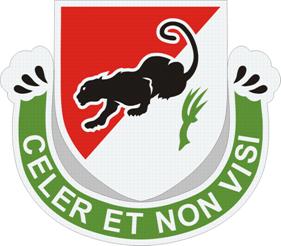
The 31st Cavalry is a historical organization within the United States Army and the Alabama Army National Guard that began as a Troop of Cavalry under "The Alabama Militia Law of 1820". The unit was constituted on 24 July 1821 in the Alabama Militia as the 1st Regiment Cavalry Troop at Jackson, Alabama
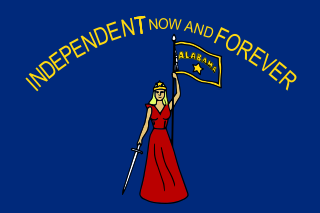
The 1st Alabama Cavalry Regiment served in the Confederate Army during the American Civil War.
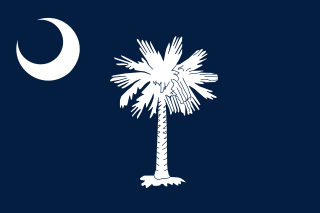
The 4th South Carolina Cavalry Regiment was a regiment of cavalry in the Confederate States Army during the American Civil War. They were from the state of South Carolina and served primarily in the Eastern Theater of the American Civil War. The 4th South Carolina Cavalry Regiment was organized on December 16, 1862, by consolidating the 10th Battalion South Carolina Cavalry, the 12th Battalion South Carolina Cavalry, the Charleston Light Dragoons and Company A of the St. James Mounted Riflemen. The 10th Cavalry Battalion was organized in the spring of 1862 with five companies, and Major James P. Adams and Major William Stokes were the commanding officers. The 12th Cavalry Battalion had also been known as the 4th Cavalry Battalion.

The Choctaw in the American Civil War participated in two major arenas—the Trans-Mississippi and Western Theaters. The Trans-Mississippi had the Choctaw Nation. The Western had the Mississippi Choctaw. The Choctaw Nation had been mostly removed west prior to the War, but the Mississippi Choctaw had remained in the east. Both the Choctaw Nation and the Mississippi Choctaw would ultimately side with the Confederate States of America.
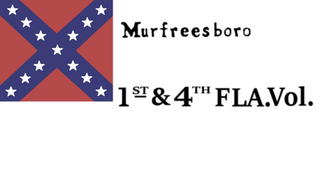
The 1st Florida Cavalry Regiment was a Confederate army unit during the U.S. Civil War, originally organized in July 1861 at Tallahassee. Members of the regiment came primarily from Alachua, Clay, Columbia, Duval, Leon, Levy, Nassau and Suwannee counties. It left for the western theater in 1862.
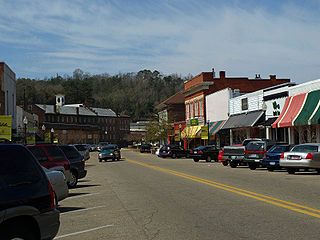
The Daniel Pratt Historic District is a historic district that includes 140 acres (57 ha) and 154 buildings in Prattville, Alabama. It is named in honor of Prattville's founder, Daniel Pratt. The district includes the historic downtown and is roughly bounded by 6th Street in the north, Northington Street in the east, 1st Street in the south, and Bridge and Court streets in the west. Architecture in the district includes the Greek Revival, Italianate, and Bungalow styles. It was listed on the National Register of Historic Places on August 30, 1984.

The 2nd Tennessee Cavalry Regiment, also known as the 22nd Tennessee Cavalry after it was consolidated with the 21st Tennessee Cavalry (Wilson’s), was a cavalry unit of the Confederate States of America during the American Civil War, organized on June 12, 1862. The unit was originally commanded by Lieutenant-Colonel Clark Russell Barteau, who was promoted from the rank of private on the day that he was placed in command of the new regiment. He was promoted to colonel a year later.
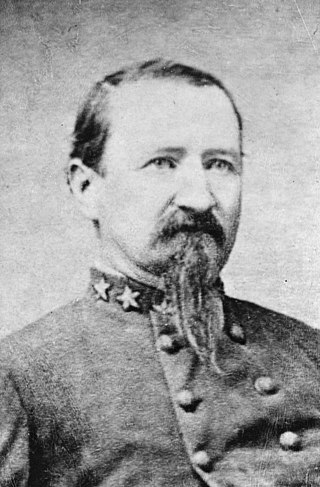
James Hagan was a United States Army captain during the Mexican–American War and a Confederate States Army colonel during the American Civil War. He was a prosperous businessman and planter at Mobile, Alabama, between the wars.
Joseph G. Sanders was a soldier from the U.S. state of Alabama who served as a commissioned officer in both the Confederate and Union armies during the U.S. Civil War. After initially joining the 31st Georgia Infantry Regiment as a private in 1861, he was elected captain of Company C in that regiment a year later, fighting for the South until he resigned his commission in January 1864 and returned to Alabama, claiming ill health.
The 53rd Alabama Cavalry Regiment, also known as the 53rd Alabama Partisan Rangers, was a cavalry regiment that served in the Confederate Army during the American Civil War.
Henry Fairchild DeBardeleben was an American coal magnate and town founder from Alabama.

The 1st Missouri Cavalry Regiment was a cavalry regiment that served in the Confederate States Army during the American Civil War.

The 7th Alabama Infantry Regiment was a Confederate volunteer infantry regiment from Alabama during the American Civil War.
The 4th Mississippi Cavalry Regiment was a cavalry unit of the Confederate States Army in the Western Theater of the American Civil War. The 4th Regiment was formed by combining various cavalry companies into one consolidated regiment in the autumn of 1862. The 4th Cavalry fought in numerous battles in Mississippi and Louisiana before surrendering at the close of the war in May 1865.